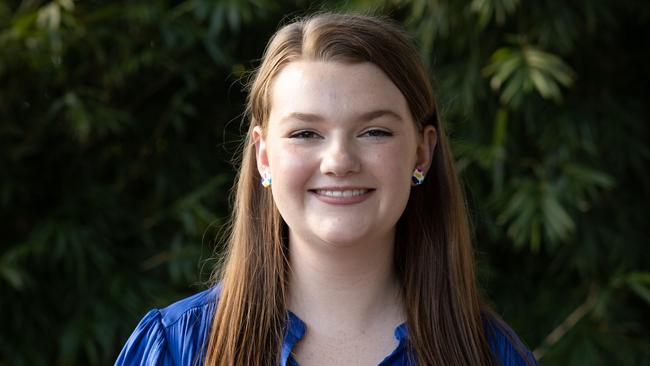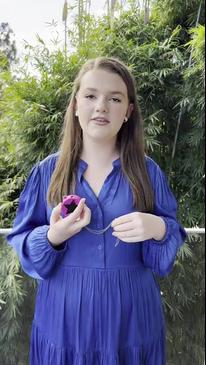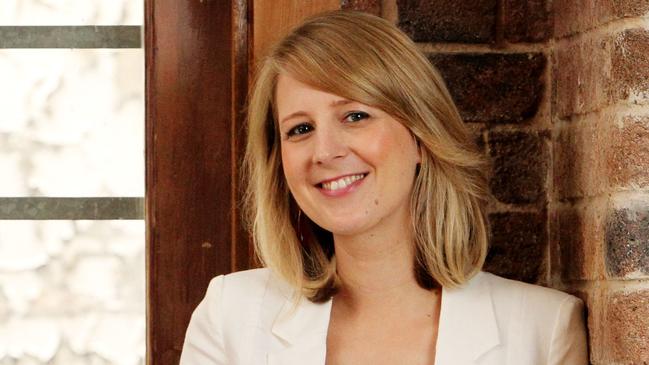
At just 16, this Qld teen runs not one, but two businesses, works part-time while attending high school and has invented a device that might just change the world.
If anyone can make you feel like you’re not achieving enough in your life, it’s 16-year-old Annie Rogers.
The Year 11 student at St Andrews Lutheran College on the Gold Coast runs not one, but two businesses, has a part-time job around attending high school full-time and was awarded National Young Entrepreneur of the Year for her incredible venture that is helping to change the lives of those who are non-verbal.
The wunderkind took her first official steps into entrepreneurship at the tender age of 12, when she signed up for an extra curricular activity in which she had to identify an issue she could solve for the greater good.
Her idea was a communication device for those who are non-verbal that would look like a necklace, rather than a medical aid, and enable a computerised voice to be projected from the person’s chest, rather than the electronic gadget usually used, encouraging eye contact between the device wearer and the other person.

The project was inspired by one of her best friends, Matilda, who has cerebral palsy and is only able to speak through her computer.
“Matilda made it clear that when she speaks – because people stand behind her – she feels that all her power lies in her computer because that’s what they use to speak to her instead of talking to her (face),” Rogers says. “So I’d really like that (power) to be restored to her and I really want her to feel human.”

Rogers evolved the idea into a business, creating My Voice Communications – to help her friend and the more than 1.2 million Australians who are non-verbal due to anything from Alzheimer’s or autism to stroke or selective mutism.
“I just want to make sure everyone has eye contact and feels respected when they speak,” the teenager says.
Rogers has spent the past four years working on the business, creating prototypes of the necklace speaker and building a website. It’s led to numerous awards including National Young Entrepreneur of the Year in the BOP Industries Next Gen Awards last year, the same competition that named her a finalist for Young Innovator of the Year. She has also been crowned One to Watch by not-for-profit social enterprise Young Change Agents. While she appreciates the accolades, her biggest dream is to meet a tech entrepreneur who can help get the device on JB Hi-Fi shelves nationally, ensuring it’s available for all.

Alongside My Voice Communications, the prodigy also runs a polymer clay earring business, selling her designs online and at Gold Coast markets. She started it as a stress relief after breaking her leg and being confined to a wheelchair for 14 weeks.
Rogers says she has had terrific female role models including her business teachers, school librarian and mother, Georgia, but having more women to look up to would motivate her to take her businesses to the next level.
“The industry professionals that I have connections with, they’re all male and my mentors are all male,” she says. “We need to increase the number of women there.”
That’s also what women in the business sector are calling for – greater equality and representation in entrepreneurship. Two-thirds of new businesses created in Australia in the past decade have been founded by women, according to the Xero Boss Insights 2020 report, while the Australian Bureau of Statistics reveals there has been a 46 per cent jump in women business owners over the past 20 years.
Despite this, the latest State of Australian Startup Funding report shows a severe imbalance in funding between male and female founders. Almost 80 per cent of start-up funding in 2023 went to all-male founding teams, 18 per cent went to “mixed teams” in which at least one woman was involved and only four per cent of capital landed in the hands of start-ups led entirely by women.
The median deal size by gender was $3m for all-male teams, $1m for mixed-gender teams and just $700,000 for all-female teams.
Nicola Hazell, founding director of SheStarts,an award-winning start-up accelerator designed for women – says in the report that there is a “persistent and significant gender gap in investment” and greater efforts need to be made to “meaningfully shift the status quo”.

“There is unequivocal evidence that women-led ventures as a general cohort deliver better returns – both for investors and for society – and diverse teams present the ultimate investment alpha. Yet this clear case for investment has failed to stimulate a substantial shift in the flows of capital, with all-male teams continuing to dominate investment portfolios,” she says. “This is a massive missed opportunity for Australia’s economic future, and for harnessing the potential of women to drive growth in our nation’s most dynamic industries (of technology and health).”
Jasmine Garnsworthy from Female FounderWorld, which supports women in business through global programs, bootcamps and events, agrees and says there are still significant inequalities facing female entrepreneurs.

“I’ve heard multiple accounts of women building companies for female consumers who get told by male investors that they’ll need to ask what their wife, daughter, sister thinks about the product before investing,” she says, insisting these misogynistic behaviours are completely unjustified when evaluating the success of female entrepreneurs.
“Women-led businesses often have the best outcomes, that’s a fact,” she says, with a Boston Consulting Group report finding businesses founded by women deliver more than twice as much per dollar invested than those founded by men. “Research shows, contrary to stereotypes, they’re driving outsized returns in categories like technology and health, so it’s not performance that’s holding back investors.”
Estimates by the World Bank Group show a roughly $1.7 trillion financing gap for women-owned small- and medium-sized enterprises globally. It found closing that gap could raise the global gross domestic product by more than 20 per cent, while adding a potential $1.48 trillion to the global economy by 2030.
“Women entrepreneurs and innovators don’t just have the potential to participate in our economy, they have the potential to lead it. And more so, to transform it,” Hazell says.
However, research shows much of the inequality when it comes to investor funding stems from an affinity bias where male investors gravitate towards “people like them”, and a tendency to assess women based on risk, and men on potential. “These barriers do not exist in isolation, but as compounding factors women founders endure throughout their start-up journey, resulting in high levels of fatigue, disillusionment, burnout,” Hazell says.
But empowering women can also have a negative effect on their success, according to research in the Harvard Business Review, which found that it can exacerbate gender bias, leading to more loan rejections and higher interest rates on business loans for women compared to men. “As women advance into higher-level positions in society, the perception that they are a threat increases,” the research says. “This prompts protective responses to safeguard existing social gender norms, triggering resistance and subsequently deteriorating conditions for women entrepreneurs in accessing critical funding.”
To counter much of this, experts believe we need to change the narrative around female entrepreneurship. That means increasing awareness of gender biases, normalising women’s empowerment, having transparent policies around venture capital investments and diversifying the pool of investors.
Hazell says we need a “national strategy” for investing in female entrepreneurs and a “system-wide road map” to implement it that involves government, industry and academics.

Also beneficial would be promoting more women entrepreneurs as role models for our youth to help the next generation of female founders, says Maddie Panther from BOP Industries, which delivers entrepreneurial and innovation workshops, masterclasses and professional development to primary and high school students. “Showcasing the success stories and lives of female entrepreneurs can inspire and motivate young girls,” she says.
BOP Industries has run programs for more than 100,000 students worldwide and Panther says they’ve had incredible outcomes with female students, including securing business seed funding and university scholarships.
“Girls often demonstrate remarkable attention to detail and strong visual skills, which enable them to particularly shine in areas such as prototyping, branding, social media, copywriting, pitching – critical components in initial phases of starting a business,” she says.
Jim Schuman from First Pivot, which runs education programs for school students, believes the key to encouraging girls into entrepreneurship lies in dismantling stereotypes and celebrating female success stories. “The old adage holds true: ‘You can’t be what you can’t see,’” he says.
“The good news is, things are changing. We are trying to accelerate this shift by highlighting female role models and introducing young girls to entrepreneurship education earlier.”
Schuman says females also have many benefits in entrepreneurship.
“Where boys tend to over-promise and underperform, girls are more pragmatic and judicious in their goals and outputs. They tend to deliver on what they set out to accomplish,” he says.
“Girls often demonstrate a strong capacity for empathy, allowing them to deeply understand customer needs and develop solutions that resonate with them. This emotional intelligence can be a powerful asset in a competitive market.”
For young girls interested in entrepreneurship, the Australian Government funds the Academy of Enterprising girls - a free entrepreneurship program targeted at those aged 10-18, designed to help them with design thinking, entrepreneurial and business skills.
It is currently holding a competition to find Australia’s Most Enterprising Girl, with the winner scoring a trip to Canberra to pitch their business idea to a theatre full of innovative leaders at the Kickstarter Challenge Grand Final at Parliament House next month.
The Academy’s spokeswoman, Fleur Anderson, says girls see unlimited possibilities for creating positive change.
“This competition will help one girl take her idea to the next level and make real inroads to creating a career they are passionate about,” she says. ■

Add your comment to this story
To join the conversation, please log in. Don't have an account? Register
Join the conversation, you are commenting as Logout
SEQ school bans student promposals, threatens suspension
An elite secondary school has banned students from ‘promposing’ to their dates for formal, with one student threatened with suspension.
Man charged with horror hammer attack on motorsport identity
A man has been arrested and charged in connection with an alleged attack on racing car driver Chris Pappas at his Gold Coast home, leaving him in a serious condition.